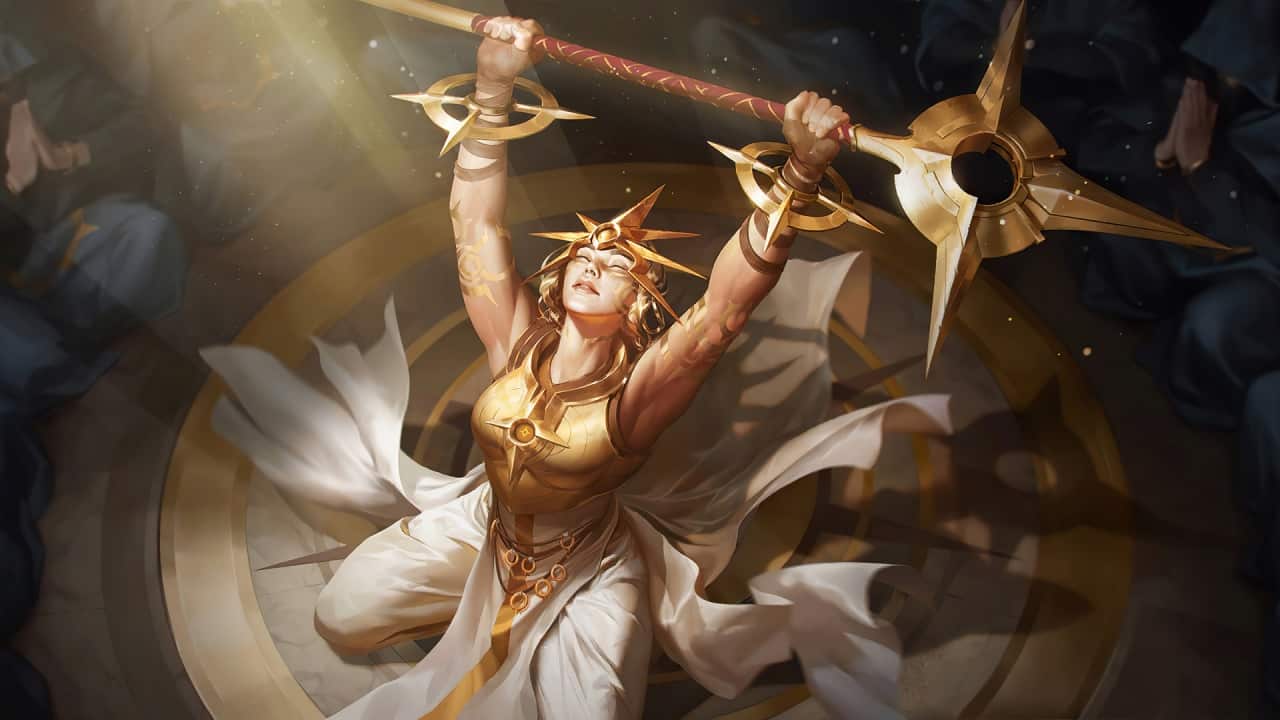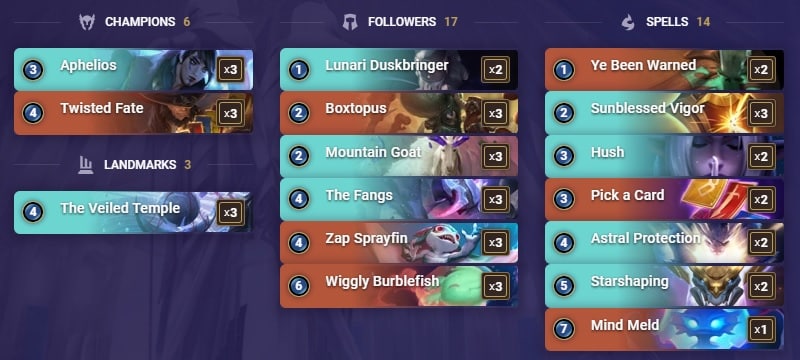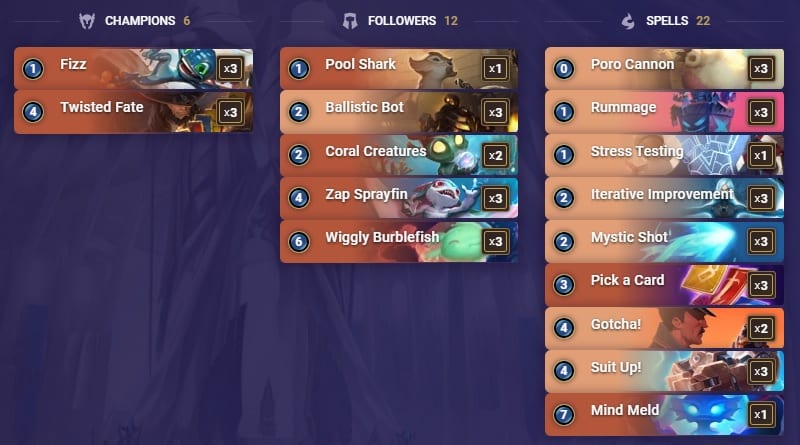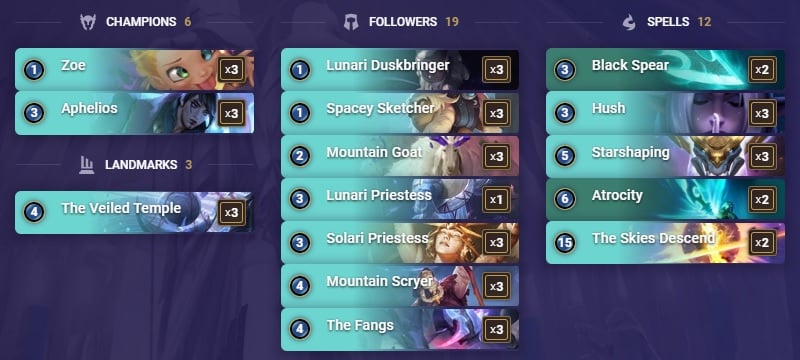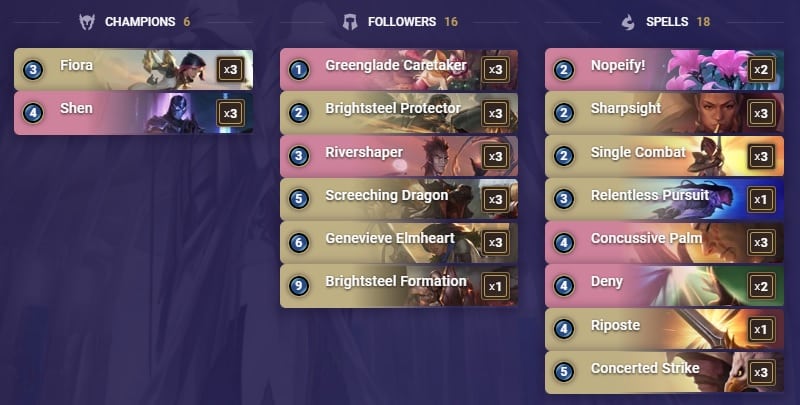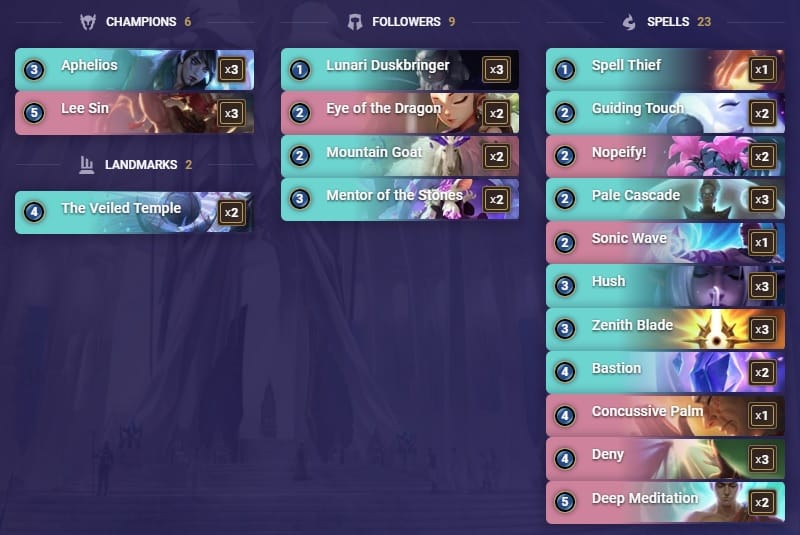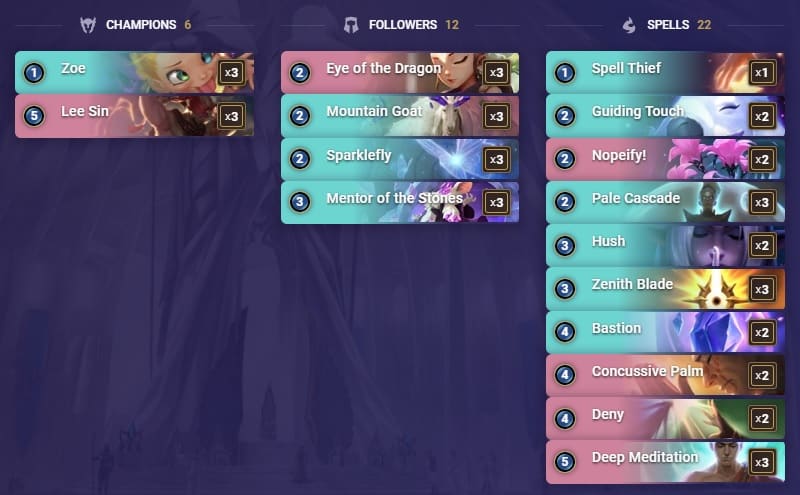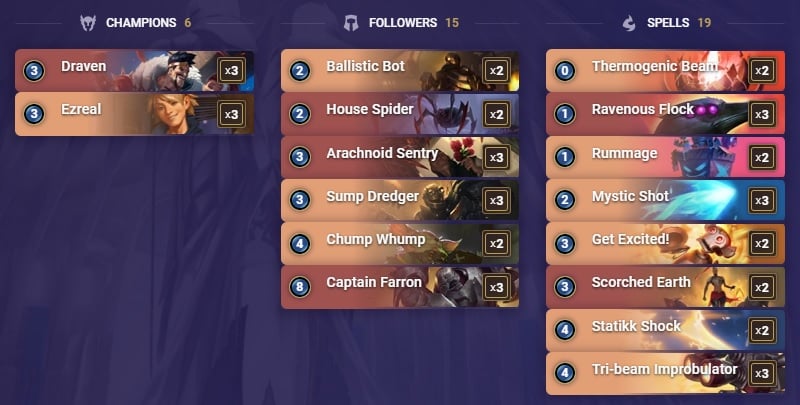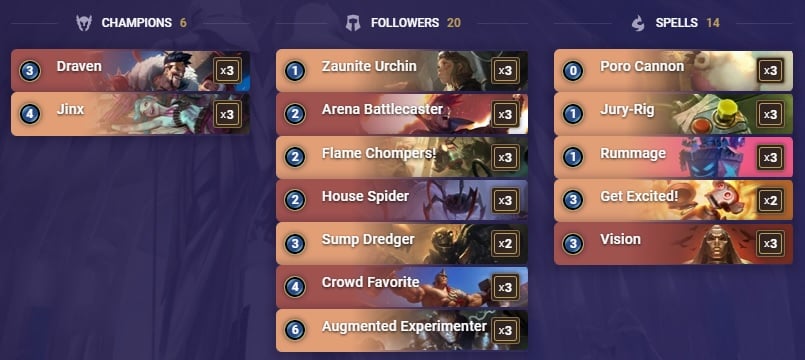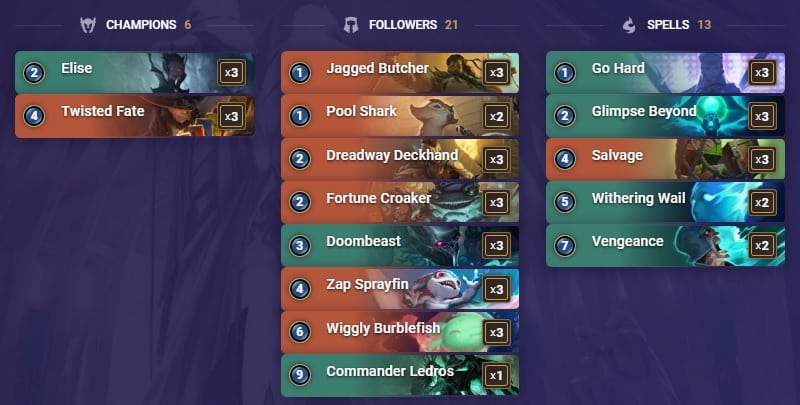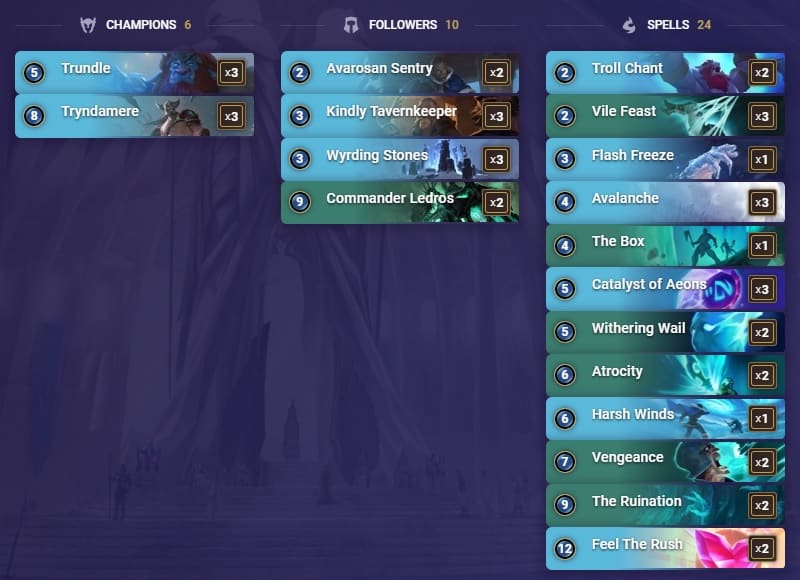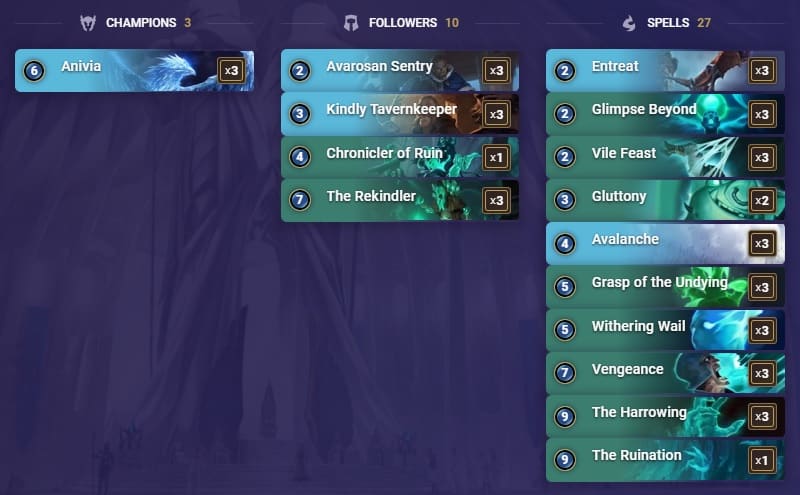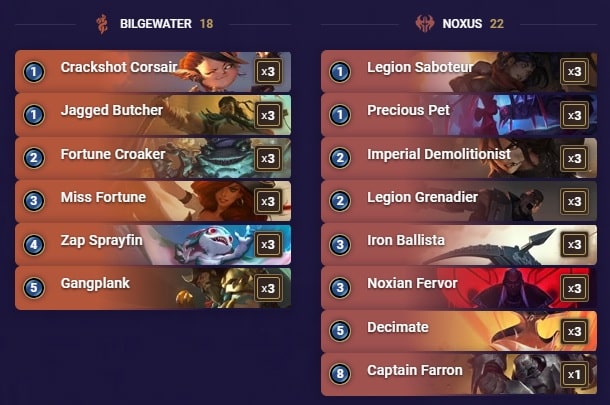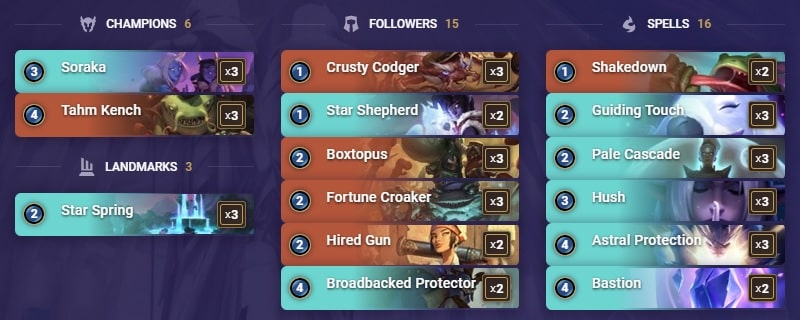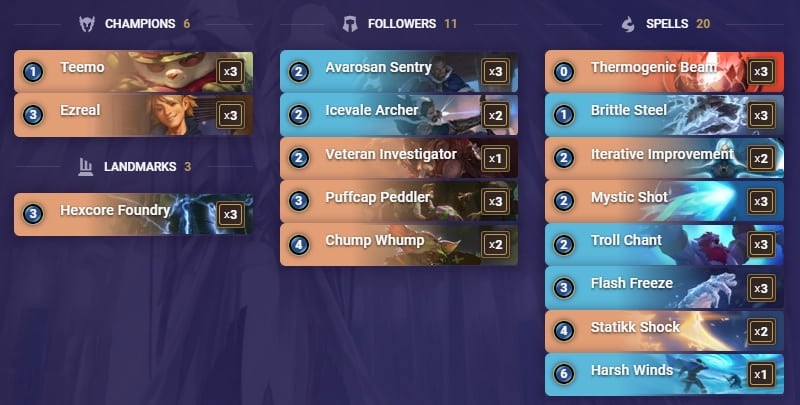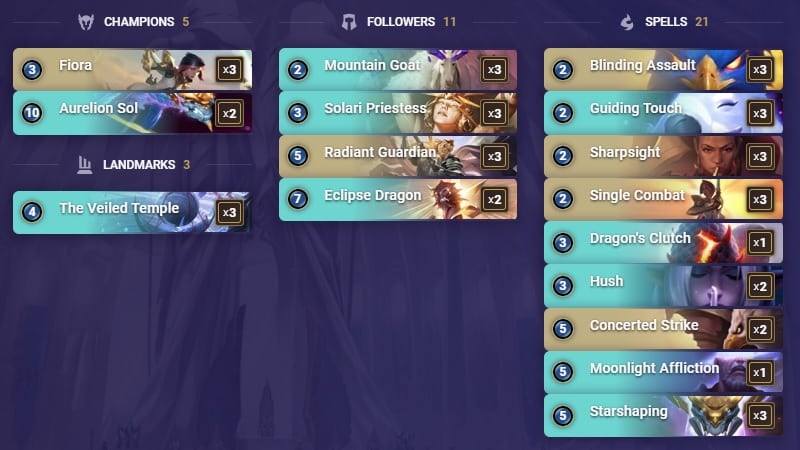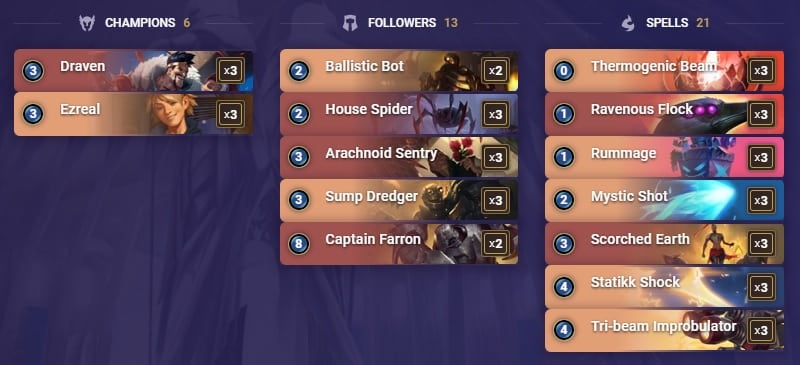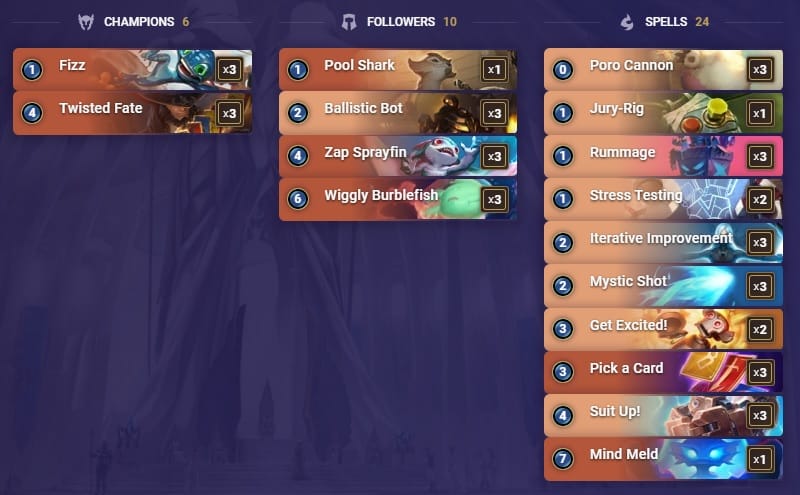Welcome to TLG’s latest meta snapshot for Legends of Runeterra, a series in which we give you our insight on the finest decks in the higher ranks of the ladder.
Every Monday, we discuss the decks that are part of the week’s meta and rate them on a scale of 1 to 5 stars. We also look at the evolution of said decks’ ratings across weeks and draw conclusions regarding the current state of the game, all of this so you can delve into your own ranked journey with a head start.
Just like last week, Twisted Fate and Aphelios are looking to be the two dominant champions and are shaping the meta. Due to the slow speed with which they take over the board, many aggressive decks have come back. As such, we can see Discard Aggro being bumped in our ratings and GP-MF finally making it back to Tier 3.
As a bonus this week, we’d like to congratulate Ultraman’s clean run in the open rounds of the EU seasonal tournament, punching his ticket to Top 32. The deck spotlight will therefore be a glance at his line-up. With Den having won the first edition of this event, our snapshot team is still looking strong and ready to perform come next Sunday.
If you have any questions, feel free to drop by our Discord. Best of luck on your climb!
Graphics: WellMax81
Editing: Crixuz, Den, Sebodunum, Ultraman, Wusubi

CIBQEAQGDITAEAYGA4IQKAYJLRRNSAO3AHOQCAQCAIDACKYEAMES2SKUKUAQCAQGFI
Difficulty: Hard
Some time has passed and the combination of TF and Aphelios still looks to be a dominant one. Aggro decks have come back on the ladder, trying to punish those very synergistic decks that don’t pack sufficient defensive tools. Well, if Fizz-TF might have suffered a bit from that, Aphelios proves that his flexibility has no limits and the Moon Weapons are great at handling pressure, whether it’s on board or Nexus-focused.
Powered by two of the best champions in the game and The Veiled Temple, this deck can find multiple win conditions and will control the pace of a game from start to finish. The deck took inspiration from the Bilgewater package of Fizz-TF, the best deck of a couple of weeks ago, and is seemingly impossible to exhaust in a resource war.
Aphelios is the main engine in the deck and the main reason behind its flexibility. The landmark takes care of tempo, giving you more mana than your opponent while buffing your units. Twisted Fate comes in as the last piece of the puzzle, helping either in a defensive role with the Red or Gold cards, or providing some more cycle with the Blue one.
While it isn’t as important to evolve TF as in Fizz-TF, the attention that Aphelios draws to him and the edge the landmark builds over time makes TF look less threatening to your opponent, giving you more time to level him up to devastating effect.
CICQCAQEAMAQGBQRAIAQIAJUAMBQIBINCICAEBQ2EYVS4AQBAIDA4AICAQDAEAIDAQMQEAQGBEVA
Difficulty: Moderate+
Fizz, the Elusive fish, still strikes fear into his opponents as a hard-to-remove win condition that only fears AoE and can outlive even those easily thanks to an early Suit Up! In some matchups, the latter alone will win you the game. Ezreal-Draven’s inability to trade or kill Fizz means they’re forced to accept multiple instances of damage each turn, meaning they’re unfavoured in the race to Nexus destruction.
Moreover, Fizz isn’t even the biggest threat this deck has to offer. Twisted Fate is an amazing powerhouse, able to sometimes level-up in 1 turn thanks to Pick a Card and Rummage. This potential to level-up so quickly is both a counter to decks that lack the possibility to remove TF instantly (mostly Targon decks) and a great pressure on Anivia and FTR decks to use their removal, giving you the opportunity of punishing them with a crazy OTK from your assembled army of Wiggly Burblefish.
In this way, the 9 damage for 0 mana that they represent is even a problem for their so-called counters that rely on one AoE to do the trick. The opponent will have questions racing through their mind: Do I let TF level-up? Will Fizz crush my Nexus? Is the Ballistic Bot going to slowly erode my defenses? Should I commit my mana to an AoE and accept that I will lose if my opponent has more Burblefish?
None of those scenarios are enjoyable for the opponent to consider, and as the Fizz-TF player, you’ll often just “Checkmate” an opponent into forcing them to remove your board, only for you to get 13+ damage in soon after.
In the end, this deck is all about forcing your opponent into making mistakes and punishing them. This can be done through Mind Meld, a TF leveling-up in one turn, Fizz denying spells, forcing an AoE on Fizz so you can then play Burblefish... Be patient and advance your pieces until your opponent is out of options and is forced to play right into your trap!
Rating change: -0.25 stars
With the return of Discard Aggro and GP-MF as popular decks, Fizz-TF has a bit of a harder time to be the finest deck around. This is because it needs a slower meta, which allows the deck more time to set up its synergies, to fully shine. The deck is still a powerhouse to be reckoned with, though, and a nicely-timed TF can solve a lot of issues, even against highly aggressive decks.

CIAQWAYJBFEUYVCVKZOGBWIB3MA52AICAEBQSAQCAECRSIQBAEBQSSY
Difficulty: Moderate
Aphelios and Zoe are the most splashed champions in the current meta, both being great tools to generate value and guide a deck into the late game. Naturally, a deck featuring both champions is a value machine that scales through the different stages of the game nicely using generating tools along the way. You get help from Mountain Scryer and The Veiled Temple, since both cards are able to generate a lot of tempo if they’re able to stay on the board.
While this deck looks like a Midrange one at first, it probably is the best late game enforcer if given the opportunity to do so. The idea is to force the opponent into a defensive position, so we can then abuse our Celestial generation and just make the problem get bigger and bigger. Atrocity is the finishing blow, often used on a Celestial unit with Spellshield, so the opponent can’t easily interact with it.
Aphelios replaced Diana in the build to further strengthen that feeling, and while Diana might be missed sometimes when we want to remove an important champion on the opposing side of the board, Calibrum has replaced her in that removal task and the other Moon Weapons offer much greater flexibility in different situations.
Because of the very fast and tempo-oriented state of the meta, this build looks to be most fragile one in Tier 2. The very Invoke-focused nature of the deck can get outpaced by other decks capable of setting-up their synergies faster.
It also doesn’t help that Aphelios-TF is capable of almost the same sustain ability, but with a better defensive package, making it a more all-around deck for ladder. In tournaments, though, this deck could find a lot of love from players, as it can be paired with Fizz-TF and represent a feared combination instead of bringing an Aphelios-TF that will likely get banned away.
CICQCAQCAUBAEAABBIBAGAAGBYBQCAAJDIWQGAICCMQCWAQBAEBDCAIDAIKACAYBAAKSKNA
Difficulty: Moderate
Demacia lost its beloved Plaza and tons of popularity in the process, but Fiora is still standing strong representing the region. Alongside her best friend Shen, the deck has once again found a way to stay one of the top decks in the meta.
The nerf to Hush was great news for the deck, and even though the card still finds its way in most of the Targon decks on our snapshot, its 3 mana cost still helps Fiora-Shen in that it demands more mana from the opponent to answer a possible barrier or Sharpsight.
Another great thing from the patch is the return of slower decks like Anivia or Go Hard for example, which are giving the Ionia region some hope to shine, as Nopeify! and Deny return as good tech choices again.
While the deck relies on the same old concepts, like the ability to control trades via the Challenger tag or using Single Combat and Concerted Strike, these are what make the deck good in the current environment. Champions like Twisted Fate, Aphelios, Zoe and Ezreal all have a game plan which focuses on survival and abuse of their passive abilities, which Demacia can deny by forcing them into combat.
This simple ability to remove the important pieces of our opponent’s game plan is enough to keep the deck relevant as of now. And even though Fiora isn’t winning so many games anymore, her presence is enough to enable the other units in the deck to pressure our opponent and force them into playing a game we’re very good at: trading.
The return of Aggro decks isn’t such bad news for Fiora-Shen, but you should adapt your build for it. Cards like Spirit’s Refuge, Fleetfeather Tracker or even the occasional Radiant Guardian are cards to consider adding to your deck if Discard Aggro and GP-MF are looking like too much of a problem for you.
Lee-Aphelios version
CIBQCAICGEAQEAQGAUBQSGZDJFK5SAIDAEBQEFACAIBAGCIFAMERGKJTLTNQCAQBAMESUAQCAICQQ
Lee-Zoe version
CIBAGAQCAMDASBQDBEERWIZIFFOAIAIBAIYQCAQCAUAQGAQUAMBQSEZTKUAQCAYJFI
Difficulty: Moderate-
While Lee Sin doesn’t look like the best option for ladder, and his pairing with Zoe is preferred for now, the blind monk has once again found a very powerful ally in Aphelios. The deck still keeps the same fundamentals, but varies the way it controls the pace of the game and gets to the Lee OTK.
Zoe is used as a way to level-up Lee Sin faster, as she generates spells and gives us flexibility to answer the opponent through Celestial cards. She is a better up-tempo card that allows the deck to play from Turn 1 and keeps the opponent busy while we are setting-up our later combos.
This faster approach looks to suit the meta better, as most decks right now are capable of snowballing in their development if we don’t interact with them in the early turns. Zoe serves as a distraction and disruption that needs to be answered.
Aphelios plays the role of an all-around support, being able to summon Eye of the Dragon or Mountain Goat with Crescendum. Furthermore, Infernum can grant Overwhelm to Lee Sin. However, Aphelios is much slower and therefore plays into the deck’s pre-existing weakness of suffering a lot from an explosive start from the opponent.
This version appears to be a more polarized option, helping to build an even greater edge in favorable matchups, but increasing the slow tendencies of the deck in the unfavorable ones.
While Fizz-TF reduced the deck’s popularity a lot lately, the return of slower decks since the patch and Aphelios making Aggro decks very hard to play on ladder is fairly good news for Lee Sin to hear. However, it looks like Ionia decks have been featuring Karma more than the blind monk this past week.
CECACAQDBEBQCBBEEY2AGAIDCQXDGAIDAQIQIBIBAQARWHZHHIAQGBAFAEAQGNYBAMBQ2AA
Difficulty: Moderate
The nerf to Captain Farron seemed like it wouldn’t be so bad for the deck, but combined with the healing potential the Targon region possesses, Ezreal-Draven is looking like a tournament deck more than a ladder one lately.
Draven is still a good champion, and his quick attack makes him a nightmare for Aphelios decks to block when he comes down on Turn 3. He usually anchors the board and builds up to a favorable position where we can leverage tempo and set-up a great attack turn. Our spells are then used to deal with opposing threats and we can snowball into the late game where Ezreal and Farron will come in and close the deal.
The problems arise once we’re unable to get in that position and we have to fight from behind. While we have a lot of spells to slow down our opponent, most of the current decks at the top of our meta snapshot can go for what seems an eternity before lacking cards to use their mana on, and our drawing potential only matches the card generation of most Targon decks at best.
At some point, we have to stop defending and try to go for the kill, which opens a window for our opponent to punish us if they can answer Captain Farron on the spot, usually creating a gap in mana usage that’s too hard to recover from.
Aphelios-TF is a good matchup on paper, as we can answer both champions with cheap spells and destroy The Veiled Temple using Scorched Earth. They also have no clear answer to an on-curve Farron or Ezreal staying in the back row. Having all of this go our way isn’t so common, though, and that’s why this deck is struggling to really take off in the current environment.
With Aggro decks returning, the meta isn’t focused around Targon decks anymore, which is wonderful news for Ezreal-Draven, a deck that relies on being very flexible.
CIBQCAYECICQCAYHBEKCONYGAECACDANDQUC2AICAECCMJYA
Difficulty: Easy
While Discard Aggro is extremely unhappy with the release of Aphelios, who can single-handedly tilt the match in his favor, the other dominant regions currently aren’t equipped to deal with a fast start.
SI and Freljord are usually the regions best able to deal with early aggression, thanks to cards like Vile Feast, Withering Wail and Avalanche being the best available options to counter the flurry or small minions that Discard Aggro aims to develop. Although they do exist, they aren’t very popular.
For Targon, Bilgewater and PnZ, although they’re flexible, they have to decide whether to answer the opponent or develop their strategy in the early turns, as they don’t have enough mana to do both.
With a deck tailored to be as explosive as possible, Discard Aggro will always find a way to pressure the opponent, forcing them to use cards they would much prefer to keep for synergies later on.
While the decks in the upper echelons of our snapshot have such a strong power level that the better players will find ways to navigate these delicate situations, the reliability that Discard Aggro shows when it comes to forcing your opponent to have the right card at the right moment shouldn’t be underestimated.
CICAEAIFGE2QEAYGBAIQEAYFAYIAKAQGAQNB2JR2AIAQEBQJAIAQKAI5AEAQCBJB
Difficulty: Easy
Another TF deck, another good matchup into most Targon’s builds. This is the main reason Go Hard was able to remain played despite the heavy nerf to Pack your Bags. Less Deny and more Midrange decks to counter also helps, however the matchup against Fiora-Shen is terrible.
Still a threat to be reckoned with, the deck preys on other Burblefish decks and Ezreal-Draven, but falls short as a counter to the best decks in the meta, strictly because of the crazy power level of those S Tier decks. This notion can be strange to understand, but sometimes, despite having an answer for just about everything, the raw numbers are too big to be handled - and that’s the case for Aphelios-TF and Fizz-TF.
The reacquaintance of the player base with Anivia decks has also been damaging to Go Hard. They disrupt your game plan of pushing damage through early followers and finishing the job with a leveled-up TF or Ledros. A leveled-up TF is hard to achieve against Avalanche, while Withering Wail will kill a part of your pressure in the middle of your attack.
Ledros can also arrive too late to stop the multiple Anivias from slowly shattering your Nexus (The Harrowing accomplishes this rather fast). Your only way out is a well-timed Wiggly Burblefish and the effect of surprise against an overconfident opponent who thinks the game is over.
The aggressive trend and the return of the long-forgotten GP-MF and Discard Aggro offers two favored match-ups for Go Hard. The mixture of healing, AoE and a low-to-the-ground curve makes for a nice answer to those decks, while the lack of late game options shouldn’t be a problem.
Watch out for Crowd Favorite and the flipped forms of Jinx and/or Gangplank and you should be fine.
CEBQCAIFFACQCAIMCQQSOMQBAMAQMAYBAEAQGAQDAEBBMBIBAUAQ6GI5EEBAEAIBAEVACAIFCM
Difficulty: Easy
Similar yet different to Anivia, FTR shares most matchups with its feathery counterpart - it suffers against Ionia and Deny decks, and although rarer nowadays, Fiora-Shen and Lee Sin still roam around, stealing free wins from your icy heart. Ezreal-Draven is the easiest foe to face, while the lack of Scouts after Plaza’s nerf definitely makes FTR feel better.
The game plan hasn’t changed and probably never will: ramp up and use Avalanche to keep the board in a reasonable state that won’t damage you too heavily before dropping Trundle to gain time and The Ruination or Withering Wail to handle your opponent’s aggression. Once all this is done, use Ledros and Atrocity or FTR’s Overwhelm champions to finish the game.
However, with so many decks brazenly cheating the mana system nowadays, the deck finds itself in a hard situation each time it has to use an AoE to handle aggression - is it worth it, can I wait longer and will I be punished by Burblefish?
While you should always ask yourself these questions, the answers might not please you: in most scenarios, your decision won’t matter as much as the ability of your opponent to punish the outrageous use of mana. Like, who needs to use mana? Seriously.
CIBAKAIBAMKBQHJSA4AQKAIDCQOSQMJWAEAQGBISAEBACBIPEA
Difficulty: Easy
The addition of Gluttony, the nerf to Hush and a good matchup into Fizz-TF had Anivia poised to be a contender after the patch, and some players consider the deck to be decent. In all honesty, we don’t have such high hopes for the deck, although we think it can be a fair Tier 2 archetype and a counter to some specific matchups in the right circumstances.
The issue with the deck is the same as before, it lacks the flexibility in the way it can use its mana. Gluttony is a great addition, allowing the player to gain some stability in the most important phase of the game for them: the transition from having one Anivia on board to having a lot of them. But the card doesn’t fix the other issues the deck has, like the fact that it has to spend between 5 and 9 mana to get any good form of AoE done.
This isn’t ideal when the average follower in the meta costs 2 to 4 mana and there are plentiful Wiggly Burblefish swimming around at zero cost by the time we get to our comfort zone. The Ruination, still the only mass removal in the game, feels like it has reached its limit and almost any deck in our snapshot can efficiently play around it or force it out before investing seriously into the board.
As such, the deck is almost forced to develop Anivia on Turn 6 in order to start chipping away at the opponent’s board, and with the flexibility decks like Fizz-TF or Lee Sin are displaying lately, the opponent can set-up a lot of ways to punish this.
Lovers of the archetype shouldn’t shy away from playing it, though, as the deck can be one of the best when it gets going and we can start multiplying the Anivias. The switch to a very defensive and health-draining build, including Grasp of the Undying instead of the usual Catalyst of Aeons makes the deck great into everything that can’t generate resources and would rely on a very aggressive strategy.

CICACAYGBABQEAYDAQCQIAIDAIHSKKAFAIDBMIBGHI6AAAIBAEBTG
Difficulty: Easy
Even with a Make It Rain nerf some patches ago, Gangplank isn’t willing to leave the meta without a fight. So he mustered his pirate brothers and sisters, co-opted his arch enemy (Miss Fortune) and is now trying to come back from the dead. How’s that for a newspaper headline?
It’s a very simple list, where you’re trying to curve out from the beginning of the game and consistently push damage on your opponent’s Nexus, so you bring it to a low amount of HP, which is ideal for a finishing touch with Decimate and Noxian Fervor. Being able to push damage turn by turn often proves useful, since you can apply the final blow with a leveled-up Gangplank; just beware of Hush.
The above prescription may include the following side-effects:
- Not attacking without Crackshot Corsair, unless your opponents have other threats they need to deal with
- Treating MF as an over-the-top damage dealer and not caring about her dying or not leveling
- Using Legion Grenadier to get additional procs for Gangplank on the defensive turns
- Baiting your opponent into using mana before killing them with a Noxian Fervor they can’t answer
- Taking full hits like a maniac and not blocking, so you have a board to apply more pressure and win the game
CEBAIAYGAQDQQDYGAMESGLJTGQ3VKAYBAMDASAYDBEJR2PABAIDAKAA
Difficulty: Moderate
Just like in almost every meta, Tahm-Soraka is an unpopular deck that can rise to a great matchup spread. The two S Tier decks both Play Mind Meld and Elusive minions, which can be a nightmare for this archetype. Aphelios-TF isn’t capable of pressuring in the same way Fizz-TF does, so its arrival is a good thing for this deck overall.
Another good point for the deck is the nerf of Plaza and the reduction in popularity of Ezreal-Draven, meaning that landmark removal isn’t so common at the moment. While Go Hard or Anivia could be running The Ruination, a very difficult AoE to play around with the deck, the Noxus region isn’t popular, meaning cards like Noxian Guillotine or Scorched Earth aren’t around to punish our big units.
As such, the main strategy of the deck is the same as it’s always been, to simply build a huge board and abuse Star Spring to win the game. This now has a higher chance of succeeding compared to the pre-patch situation.
While most top tier decks have a potential that surpasses that of Tahm-Soraka’s when everything goes their way, it’s clear that Star Spring is a potent landmark and the high health count of both Soraka and Tahm Kench makes them difficult to kill, forcing most decks into a race to the Nexus.
Considering the impact of Aphelios on the current meta and the fact that direct damage isn’t popular outside of Ezreal-Teemo, this deck might have a way to find its place to shine. Although having the Targon/Bilgewater combination of regions is a really bad thing when you have to compare yourself to Aphelios-TF in terms of strength come tournament time, Tahm and Soraka’s unique defensive combination might be one of the decks on the rise in the next few weeks.
CICACAYBAIAQGBAUAMAQCAIDDYCQCBAIDENSINADAEAQCCYBAMCA2AQBAQPTUAQBAEASUAICAQFA
Difficulty: Moderate
At its core, Teemo-Ezreal is a Teemo or Poison Puffcap-focused deck. You want to mulligan for Teemo and Puffcap Peddler to get your engine going. The deck deliberately plays cheap spells, allowing you to maximize your Puffcap generation.
Every Freljord-PnZ deck ultimately needs to solve the problem of limited card draw. Previously, this mainly came in the form of Statikk Shock or Progress Day! The introduction of Hexcore Foundry, however, has meant that the region pair has a new way to avoid running out of steam. Yet, given Foundry’s bilateral effect, timing its use is important.
Many players play Foundry in early turns, as a way to improve their bricked hands. This is usually a bad play, as you’ll allow the opponent to advance further. Rather, aim to play Foundry when the opponent has a hefty amount of Puffcaps in their deck or when you get to a certain turning point.
The turning point can be recognized by asking “If I play Hexcore Foundry now, and both players each draw one additional card per turn, who’s more punished by it? Is the advantage that my opponent gains from drawing one additional card much greater than the advantage I gain?”
This analysis will depend on the natural strength of the cards they can draw, the mana that they’ll have going into the next few turns (if their cards are all 10 mana and the game is at T5, you may safely play Foundry), the potential number of turns that they will destroy their Nexus from the extra card they draw (due to the Puffcaps), your health or ability to chump block, etc.
Basically, knowing when to play your Foundry is the toughest element of this deck. Whatever it is, the answer is nearly always not going to be Turn 3 and the landmark will mostly likely be played on Turn 5-8.
Rating change: -0.25 stars
While the deck had a great week the last time we talked about it, the rise of Discard Aggro and GP-MF did show the limits of Teemo’s Puffcaps. Although it’s still a very valid choice for a target strategy, the deck cannot fight efficiently against decks that are capable of racing from T1 and go wide onto the board, as the Freeze mechanic is mostly a single target strategy.
Although the deck shouldn’t be forgotten, it falls to Tier 3 for now with the environment change.

CICACAQDAMBAGBIEAYBQCBJPGU4AKAIDAIHRSJJXAMAQCAZTAEAQKJYBAIBQIAIBAEBSQ
Difficulty: Easy
Elise Burn is an aggressive deck with consistency as a hallmark of the list. You always want to play T1 Precious Pet into T2 Elise. This is true for about 99% of the time, regardless of matchups. You might believe that this is an easy deck to play, and you aren’t entirely wrong. However, as with many decks, the skill ceiling can be a lot higher than you imagine.
The deck wants to push for 5 damage by T2-3, then set up for a huge Frenzied Skitterer attack that can kill your opponent as early as T5. Any remaining damage can be finished off with your Burn damage, of which this deck has a plethora (Doombeast, Noxian Fervor, Decimate). The rest of this post will go through the intricacies of playing Elise Burn at high level.
What if you don’t draw some combination of Precious Pet, Elise and Frenzied Skitterer to set up for a Fearsome Spiders attack? Do you force yourself to play that Legion Grenadier or House Spider without the follow up? If you do that, you will find that you will have run out of cards by T6-7 and only almost killed your opponent before they managed to stabilize.
This is a decisive deck. The two rules to playing it is to always have some follow up play and to always ensure you decisively kill your opponent, so as to avoid these “almost” situations.
To do that, if you find that your draws aren’t good, it’s necessary to pass. Your opponent should expect you to attack every turn and pass to you first because they want to react rather than play proactively. For example, they’re thinking to themselves that they can cast Mystic Shot anytime, even during your attack, so why not wait for you to attack before casting it in case you play another more valuable target for Mystic Shot. If you pass cleverly multiple times, you find that suddenly you draw the damage you need to win the game.
The deck runs three copies of Brothers’ Bond. This seems unorthodox, but it’s powerful. The common misconception is to play Brothers’ Bond very late. For example, it’s a mistake to not keep Brothers’ Bond in the mulligan when you already have a T1 and T2 play. When you play Brothers’ Bond on T5 onwards, your opponent has the mana to react to it.
They could Hush it, Concussive Palm, or simply block it because they have units to block. But, if you play Brothers’ Bond on T3, maybe on an Elise, they’re likely to have no mana or units to block it.
Next, we have Fading Memories. This is an exercise in the Redundancy Theory in card games. The theory states that “if you have a good card, having more copies of it is a good thing, even if they’re less powerful versions of it.”
For example, if having Decimate is good, then having Aftershock is also good. What this means for Elise Burn is that you will use Fading Memories to copy your high impact followers - Doombeast, Imperial Demolitionist and Frenzied Skitterer.
In summary, always mull for your Precious Pet and Elise, play Brothers’ Bond early if you can or think about how you can play Brothers’ Bond with little to no chance of it being answered, pass when your hand doesn’t allow you to kill the opponent in the near future so that you draw and see more cards. And, lastly, learn how to play Fading Memories properly. (Write-up by Crixuz)
CICACAQAAIAQGAAOAMAQADY2FUCQGCJTKROGBWYBAIAQEAABAMBQSVKXMQAQEAYJAMGQ
Difficulty: Moderate
Fiora-ASol employs Fiora to control the early to mid game, while playing The Veiled Temple whenever the space presents itself to cheat out an early ASol. The list does very well against Aphelios decks because Sharpsight and Fiora will always beat Aphelios and Pale Cascade. It also does well against champions with lower stats like Twisted Fate and Teemo.
The list has a lot of survival tools, such as Radiant Guardian, and does very well into Aggro decks. It eschews the Plaza package because it needs to answer Aphelios (or any similar champion) and that T3 is so crucial that we cannot permit a tempo loss by playing a landmark. Once the board is sufficiently controlled, you can look to play The Veiled Temple and then ASol.
Between these, your hand might start running dry. Don’t worry, though, as you should have just enough to tide you over with Guiding Touch, Solari Priestess and Dragon’s Clutch. Once you play ASol, your hand should always be full, allowing you to take over the late game with powerful Celestials.
CIBQCAICFEBAEAQDAUEAGCJTKRKVMYGXAHMQDWYBAMAQCARRAEBQEFABAMEUSAIBAIBAS
Difficulty: Hard
Similarly to Zoe-Karma, this is a stall deck that will be able to win the game once Karma is leveled-up or when the big Celestial units come into play. One of the deck’s best survival tools is the Eye of the Dragon, which can be tutored with Crescendum, as it’s your only 2 mana unit. Thanks to multiple Eye of the Dragons and Aphelios, the deck can easily deal with Aggro.
Against most other Aphelios decks (e.g. Aphelios-TF), Karma-Aphelios tends to dominate, as it has more value in the late game due to Starshaping and Solari Priestess.

This week, we will feature three decks in our spotlight, as our very own Ultraman went undefeated in the seasonal open rounds, punching his ticket to the Top 32! Here’s his line-up and a bit of his thought process behind it.
Ezreal-Draven
CICQCAQDBEAQGAYNAEBQIEIDAEBRILRXAYAQIAI3D4SCMNACAEAQGMYBAMCAKAA
Fizz-TF
CICQCAQEAMAQGBQRAIAQIAJUAMBQIBINCICAEBQ2EYVS4AQBAECCOAIDAQMQEAIBAQOAEAQGBEVA
Karma-Aphelios
CIBQCAICFEBAEAQDAUEAGCJTKRKVMYGXAHMQDWYBAMAQCARRAEBQEFABAMEUSAIBAIBAS
The main idea of my line-up was to soft-target Fiora-Shen and Aphelios-TF. I expected to encounter many of those; the latter for being the strongest deck in the history of the game and the former for being a stability pick, loved by many tournament players for its good matchup spread.
I knew not many people would consider Ezreal-Draven as a threat, given it was nerfed not too long ago, and I doubted people would bring a heavy control SI line-up into such a large field, as they might run into Ionia line-ups, especially given that Fizz-TF is such a hard deck to counter.
It sounded easier for everybody to simply ban TF in general, be it Fizz-TF or Aphelios-TF, than to build line-ups to counter those specifically. I went with decent decks that I liked. Fizz-TF was my first lock-in, as I knew I could play well with it. Ezreal-Draven joined this, as I found it to be a counter to both the decks I was targeting.
My last pick, Karma-Aphelios, was actually a first time for me. It seemed like the deck could beat Fiora-Shen and most Aphelios lists while also not having to worry about the Fizz-TF matchup, as it was already a ban target for me from the beginning.
Abusing The Veiled Temple with Karma and duplicating high cost spells would be a big issue for Aphelios-TF. In theory. I could only test this out in practice if I actually added Temple to my list, which I somehow forgot to do. All I can say is: “never punished.”
TF was a problem, but it was great into Aphelios-Zoe and Aphelios-Viktor, both decks I had to face during the tournament. I also seemed to disagree heavily with my opponents on ban strategies, as my Fizz-TF gathered quite a lot of bans against unfavored line-ups, meaning my opponents were afraid of the deck’s power level despite the great matchup they had against Fizz.
In all honesty, I would have banned differently than my opponents did in all five rounds, which surprised me. I ended up having way more bans than I’d have expected onto Fizz-TF and Karma-Aphelios, while everybody underestimated Ezreal-Draven, which ended up doing great in the tourney. In summary, never underestimate the nerfed decks! (Write-up by Ultraman)

